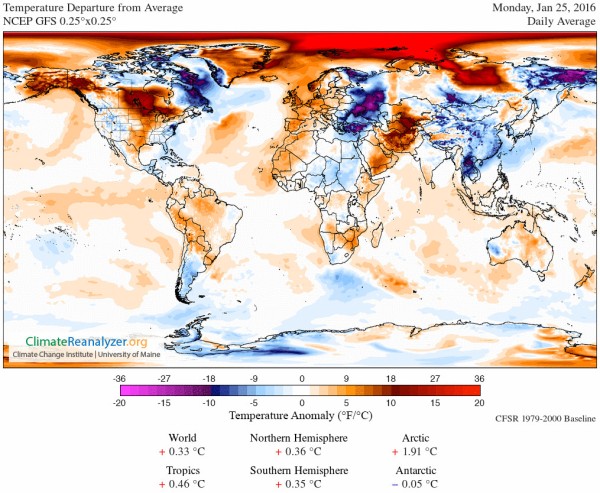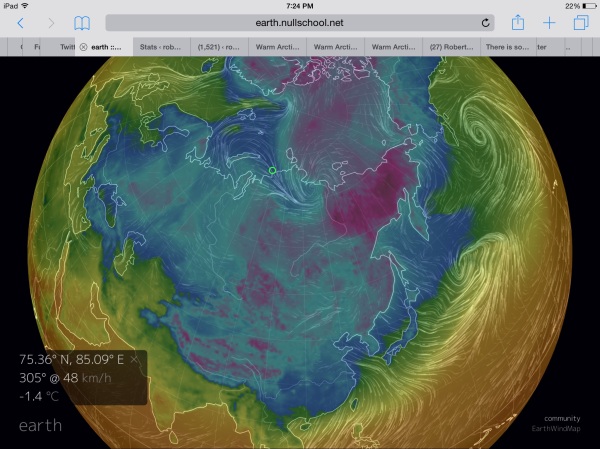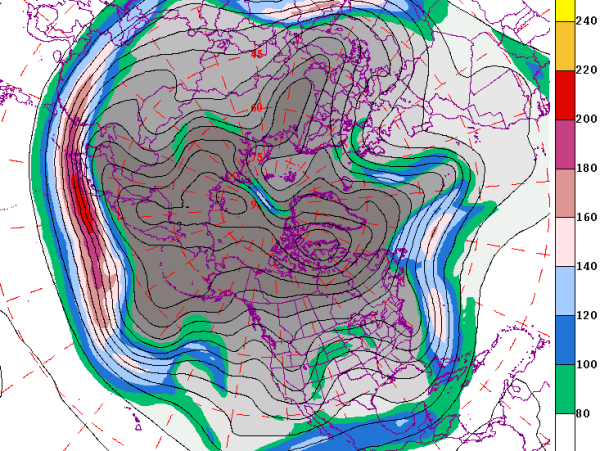Arctic Heatwave Drives Deadly Asian Cold Snap
25
January, 2016
In
the Arctic today, there’s a warm wind howling over Siberia. It’s
a wind blowing from the northwest. A wind originating from the Arctic
Ocean. Siberia is warming up today because warm air blew in from the
direction of the North Pole. This should strike everyone as
ridiculously, insanely odd.
****
In
Okinawa it snowed for the first time on record this weekend. In
Taiwan, a cold snap turned deadly killing 85 as tens of thousands
more huddled in homes that lacked any form of central heating.
In South Korea, 500 flights were grounded due to unseasonable
weather. In Hong Kong, the temperature was 3 C — the same
temperature as a region near the southwestern coast of Svalbard east
of Greenland and above the Arctic Circle.
What
the hell is going on? In short, a global warming driven heat-up of
the Arctic has punched a hole in the Jet Stream and driven chill,
Arctic air all the way into portions of Southeast Asia that seldom
ever see temperatures go below 60 degrees Fahrenheit (16 Celsius).
An
Arctic Super-Warmed By Climate Change
Temperatures
in the Arctic are just off the charts warm for this time of year.
It’s the sad result for a region that now sits in the bull’s eye
of rapid heat accumulation due to human greenhouse gas emissions
forcing the world above 400 parts per million CO2 and 485 parts per
million CO2e. CO2 levels alone that have not been seen in at least 3
million years and a ridiculous total heat forcing at the top of the
atmosphere that likely hasn’t been seen for all of the past 10
million years.
(Extreme
heat in the High Arctic brings summer-like seasonality to that region
even as a record cold snap grips sections of Southeast Asia. Image
source: Climate
Reanalyzer.)
It’s
the kind of heat forcing that has a profound, far-ranging impacts.
Impacts, that for many regions of our world, start in the Arctic.
There,
in the long dark of polar night, all that overburden of greenhouse
gasses is doing its work to re-radiate the sun’s heat. And the
ocean sitting beneath the inexorably thinning and greatly reduced sea
ice is also transporting that accumulated heat into the Arctic air.
Firing off weather systems that run northward in Kamikaze fashion.
Surging up through the gauntlet of Greenland chill along that
increasingly dangerous storm bombification zone of the North
Atlantic. Howling over Svalbard and into the Arctic itself. Giant
heat engines aimed directly at the Arctic’s heart.
And
heat the Arctic in strange and stunning fashion all of these various
processes do — with a large region of extreme, above average
temperatures stretching from the North Pole itself, to the northeast
tip of Greenland, all throughout a quarter-pie section of the High
Arctic above the 80th parallel, on into the Kara, the Laptev, and
finally terminating in what should be deeply frozen North-Central
Siberia. This entire vast region features temperatures in the range
of 20 degrees Celsius or more (36 degrees Fahrenheit) above average
for this time of year. For today, for this vast section of the
Arctic, it’s as if the Winter Season did not exist.
Extreme
Warmth in the Arctic, Cold in Southeast Asia
(Gale
force northwesterly winds bring much warmer than usual temperatures
to Northeastern Siberia even as record cold hits Southeast Asia.
Image source: Earth
Nullschool.)
Just
off the coast of Svalbard the current temperature is 3.7 C (or 39
degrees F). That’s the
same reading that Taipei City Taiwan, thousands of miles to the south
and sitting in the ridiculously warm Southwest Pacific, saw
yesterday.
Running along the zero degree Longitude line to 85 North, just a few
hundred miles from the North Pole, we find 1 C or 34 F temperatures.
Temperatures run near or even above freezing along a vast section of
ice-covered waters in the Arctic Ocean above 80 North Latitude and on
toward the coast of Siberia. There at 74.5 North and 87.55 East, a
freakishly warm northwest wind howling out of the Arctic Ocean is
pushing temperatures to -1.4 C (29.5 F and above the point at which
salty ocean water freezes). It’s colder now in the hills of North
Vietnam at 20.1 North Latitude, 103.9 East Longitude with
temperatures there hitting -1.5 C (29.3 F).
This
is worth repeating — it’s colder in North Vietnam than it is on
the shores of Arctic Siberia. Something, most definitely is not right
with the weather.
Predictable
Seasons Disrupted
To
understand what, we need to think for a little bit about atmospheric
physics. In a normal world — meaning the world in which we’re
used to living, the same world in which human civilization developed
and evolved — cold remains mostly locked in the Arctic. Heat
remains most highly concentrated at the Equator. This is due to the
fact that at the greenhouse gas levels of the Holocene (in the range
of 275 parts per million CO2 and 600 parts per billion methane) solar
insolation — or the direct heating of the Earth’s surface by the
sun’s rays — was more-so in the driver’s seat. The blanket of
greenhouse gasses was in that nice Goldilocks zone where its heat
trapping ability was just enough to keep the Equator hot, the mid
Latitudes mostly warm, and the poles cold. Just right.
This
just right atmospheric heat balance with cold at the poles and heat
at the Equator set up a large temperature difference between the low
Latitudes and the Poles. This high degree of thermal difference, in
turn, drove strong circumpolar winds called the Jet Stream that
mostly kept the climate zones stable and locked in place. In the
north, it was cold, as it should be. And, in the south, it was hot,
as it should be. That rapidly moving wall of upper level air did its
part to keep the climates divided and stable. To keep the seasons we
now know in their appropriate phases and predictable progressions —
Winter, Spring, Summer, and Fall (please see Dr
Jennifer Francis — Jet Stream and Climate Change).
But
now, with greenhouse gasses rocketing to above 400 parts per million
CO2 and above 1830 parts per million methane, the Goldilocks zone for
human climate is no more. Now, the purity of polar cold has been
violated by floods of heat rushing up from the south and oozing up
through the ocean itself. Now, that kind regulator of the seasons —
the Jet Stream — has been driven into a helter-skelter tangle. And
this is why it’s warmer in the Arctic than it is in parts of
Southeast Asia.
Arctic
Heat Drives Asia Chill
(Warm
air injected into the Arctic through a weakness in the Jet Stream
over the North Atlantic drives a polar vortex disruption, strong
trough formation over Eastern Siberia and a record Asian cold snap.
Image source: University
of Washington Jet Stream Analysis)
And
it’s exactly the kind of scenario that happened this weekend
through today. A weakness in the Jet Stream just west of the United
Kingdom developed — allowing warm air to flood northward into the
Arctic. While the UK and sections of the Arctic began to experience
warm temperatures more usual for Spring and Summer in the affected
regions, polar cold was driven southward — this time down another
weakness in the Jet Stream that developed over Siberia through
Southeast Asia.
It’s
the kind of polar vortex disruption, distortion and collapse that
we’ve seen so much of during recent Winters. A pattern of warm
north, cold south that is the very upshot of a rapidly warming world
and an equally swiftly destabilizing climate system.
Links:
Hat
Tip to Greg
Hat
Tip to DT Lange
Hat
Tip to Ryan in New England






No comments:
Post a Comment
Note: only a member of this blog may post a comment.